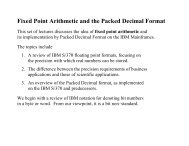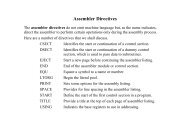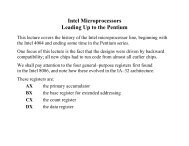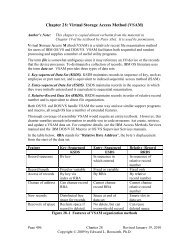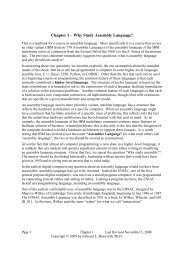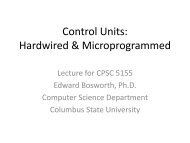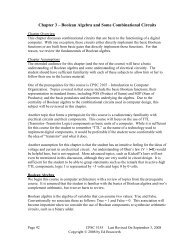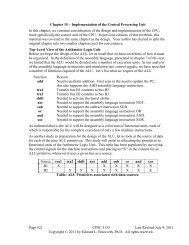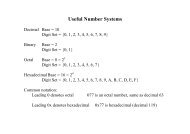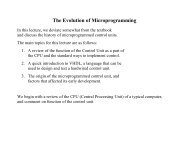PDF Version - Edwardbosworth.com
PDF Version - Edwardbosworth.com
PDF Version - Edwardbosworth.com
You also want an ePaper? Increase the reach of your titles
YUMPU automatically turns print PDFs into web optimized ePapers that Google loves.
S/370 Assembler Language Binary Integer Data<br />
RX (Register–Indexed Storage): Explicit Base Register Usage<br />
This is a four–byte instruction of the form OP R1,D2(X2,B2).<br />
Type Bytes Operands 1 2 3 4<br />
RX 4 R1,D2(X2,B2) OP R 1 X 2 B 2 D 2 D 2 D 2<br />
The first byte contains the 8–bit instruction code.<br />
The second byte contains two 4–bit fields, each of which encodes a register number. The<br />
first hexadecimal digit, denoted R 1 , identifies the register to be used as either the source or<br />
destination for the data. The second hexadecimal digit, denoted X 2 , identifies the register to<br />
be used as the index. If the value is 0, indexed addressing is not used.<br />
The third and fourth bytes contain a standard address in base/displacement format.<br />
As an examples of this type, we consider the two following instructions:<br />
L Load Fullword Opcode isX‘58’<br />
A Add Fullword Opcode isX‘5A’<br />
We consider a number of examples based on the following data declarations. Note that the<br />
data are defined in consecutive fullwords in memory, so that fixed offset addressing can be<br />
employed. Each fullword has a length of four bytes.<br />
DAT1 DC F‘1111’<br />
DAT2 DC F‘2222’ AT ADDRESS (DAT1 + 4)<br />
DAT3 DC F‘3333’ AT ADDRESS (DAT2 + 4) OR (DAT1 + 8)<br />
A standard code block might appear as follows.<br />
L R5,DAT1<br />
A R5,DAT2<br />
A R5,DAT3 NOW HAVE THE SUM.<br />
One variant of this code might be the following. See page 92 of R_17.<br />
LA R3,DAT1 GET ADDRESS INTO R3<br />
L R5,0(,3) LOAD DAT1 INTO R5<br />
A R5,4(,3) ADD DAT2, AT ADDRESS DAT1+4.<br />
A R5,8(,3) ADD DAT3, AT ADDRESS DAT1+8.<br />
Note the leading <strong>com</strong>ma in the construct(,3), which is of the form (Index, Base). This<br />
indicates that no index register is being used, but that R3 is being used as a base register. It is<br />
equivalent to the construct(0,3), which might be preferred.<br />
Here is another variant of the above code.<br />
LA R3,DAT1 GET ADDRESS INTO R3<br />
LA R8,4 VALUE 4 INTO REGISTER 8<br />
LA R9,8 VALUE 8 INTO REGISTER 9<br />
L R5,0(0,3) LOAD DAT1 INTO R5<br />
A R5,0(8,3) ADD DAT2, AT ADDRESS DAT1+4.<br />
A R5,0(9,3) ADD DAT3, AT ADDRESS DAT1+8.<br />
Page 225 Chapter 12 Last Revised July 6, 2009<br />
Copyright © 2009 by Edward L. Bosworth, Ph.D.



